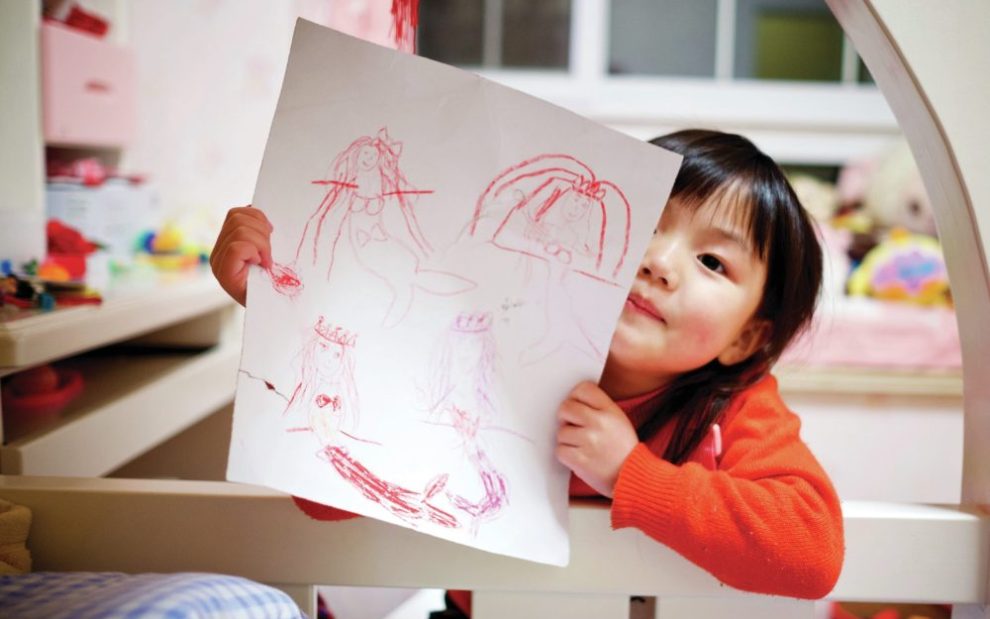“Mommy, why aren’t you happy just the way God made you?!” When my 8-year-old daughter posed this query with tears streaming down her face, it was a punch to the gut. I had just walked through the door after coloring my hair for the first time ever—a stress response to a family crisis that was unfolding at the time. My hair was bouncy and shiny, so my heart felt a little lighter too. But when I saw the betrayal clouding my daughter’s eyes, my newfound lightness deflated.
As anyone who has interacted with children can confirm, kids have a direct and insightful way of calling attention to our failures that is both beautiful and heartbreaking. Instantly, I realized that, in my need to alleviate some traumatic pressure, I had forgotten to consider the impact my actions would have on the little ones who look up to me. I had let my kids down, becoming less worthy of emulation in their eyes. That was a hard blow to my ego.
You may be wondering why something as benign as hair dye caused such a strong reaction, so I should emphasize that I am not suggesting that coloring one’s hair is sinful. There are certainly myriad worse actions I could have undertaken as emotional salve. However, keeping my hair natural is one way I choose to be countercultural—to model for my kids that beauty is not about the application of external products, to help them see that they are beautiful just the way they are, and to teach them to avoid participation in what Pope Francis has dubbed the “throwaway culture.”
Ironically, the waste generated by the so-called “beauty” industry contributes to the deterioration of our planet: The beauty industry is responsible for billions of units of single-use plastics and tons of carbon emissions annually, and it is a primary driver of child labor. Because of the overwhelming production of materials that are discarded when we finish with them, “the earth, our home,” Pope Francis writes in the 2015 encyclical Laudato Si’ (On Care for Our Common Home), “is beginning to look more and more like an immense pile of filth.” Our society’s anti-aging obsession is incredibly detrimental to the health and well-being of our planet, people who are poor, and women generally. It is also counterproductive: The one thing that is literally impossible to achieve is what we have decided is ideal. It is rather unfair.
So, I keep my hair its natural color, wear a minimal amount of makeup, and try not to worry too much about the gray strands and wrinkles that are beginning to appear as I approach middle age. My children know this, and they know my reasons.
When I came home with highlights, my kids recognized that I had violated my moral principles on some level, and their world shifted a bit. In that moment, they recognized that I was not the paragon of moral integrity they had always thought.
This was bound to happen sometime. I can remember the first time I realized that my parents were not perfect. For some of us it happens earlier than others; for some it is more traumatic. But the recognition of moral imperfection is inevitable because, of course, we are all imperfect.
If we hold ourselves to the standard of perfection, our pride becomes a distraction from the grace of Christ.
Advertisement
Nevertheless, my first reaction to my daughter’s critique was to make excuses: “This is a one-time thing.” “I just needed a change.” “There’s really nothing wrong with this, and I don’t understand why you’re so upset.” But when I allowed myself to receive her criticism, I realized that her question held implications beyond hair color. The pointed yet gentle rebuke reminded me that being “happy just the way God made me” means accepting my limitations and flaws.
Although I want to be a moral exemplar for my kids, perhaps the most important virtue I can model for them is humility—the ability to receive criticism, to apologize when I am wrong, and to point them toward the only One who is perfect. You see, the way God made me—and all of us, actually—is in Christ’s image: Christ, who actually is the paragon of virtue and whose humility reveals the fundamental aspect of being human.
We humans are born with a desire for control—of ourselves, our lives, and the world around us. The limitations of earthly life do not sit well with us, for we are born for eternity. But if we hold ourselves to the standard of perfection, our pride becomes a distraction from the grace of Christ. Indeed, the recognition of our shortcomings enables us to be compassionate toward others: If we believe we have the capacity for perfection, then we expect others to achieve it as well. This, however, imposes unfair expectations on us all and promises to leave us disappointed. Striving to be virtuous is, of course, an admirable ambition, as long as we recognize that whatever virtue we possess is the result of grace and that our moral failures are only evidence that we must look beyond ourselves for perfection. To quote Pope Francis in Laudato Si’ again, “Once we lose our humility, and become enthralled with the possibility of limitless mastery over everything, we inevitably end up harming society and the environment,” and, I would argue, our kids.
Humility empowers us to accept the uncontrollable elements of this life. This not only bolsters our efforts to be virtuous, but it also can help alleviate some pressures of parenting. Parenting can often feel like all eyes are on us—like our children, observing and absorbing our actions and attitudes, will forever bear the imprint of our choices. While there is an element of truth in this, and parenting is certainly about raising our children to live faithfully, it is also fundamentally about learning humility through the practice of letting go. We simply cannot control everything, and we are not meant to do so. Even if we make all the “right” choices, there is no guarantee that our children will absorb the right messages. Showing ourselves compassion when we make mistakes can expand our capacity to love our kids, which is likely the most effective means of pointing them to Christ.
So, I apologized to my kids for letting them down, and they assured me that I was forgiven. A few weeks later, my 6-year-old had to complete an assignment for his religious education program, which instructed him to draw a picture of a holy person. When I checked his work, there I was—highlights and all, in stick-figure glory.
This article also appears in the March 2022 issue of U.S. Catholic (Vol. 87, No. 3, pages 43-44). Click here to subscribe to the magazine.
Image: Unsplash/Jerry Wang













Add comment